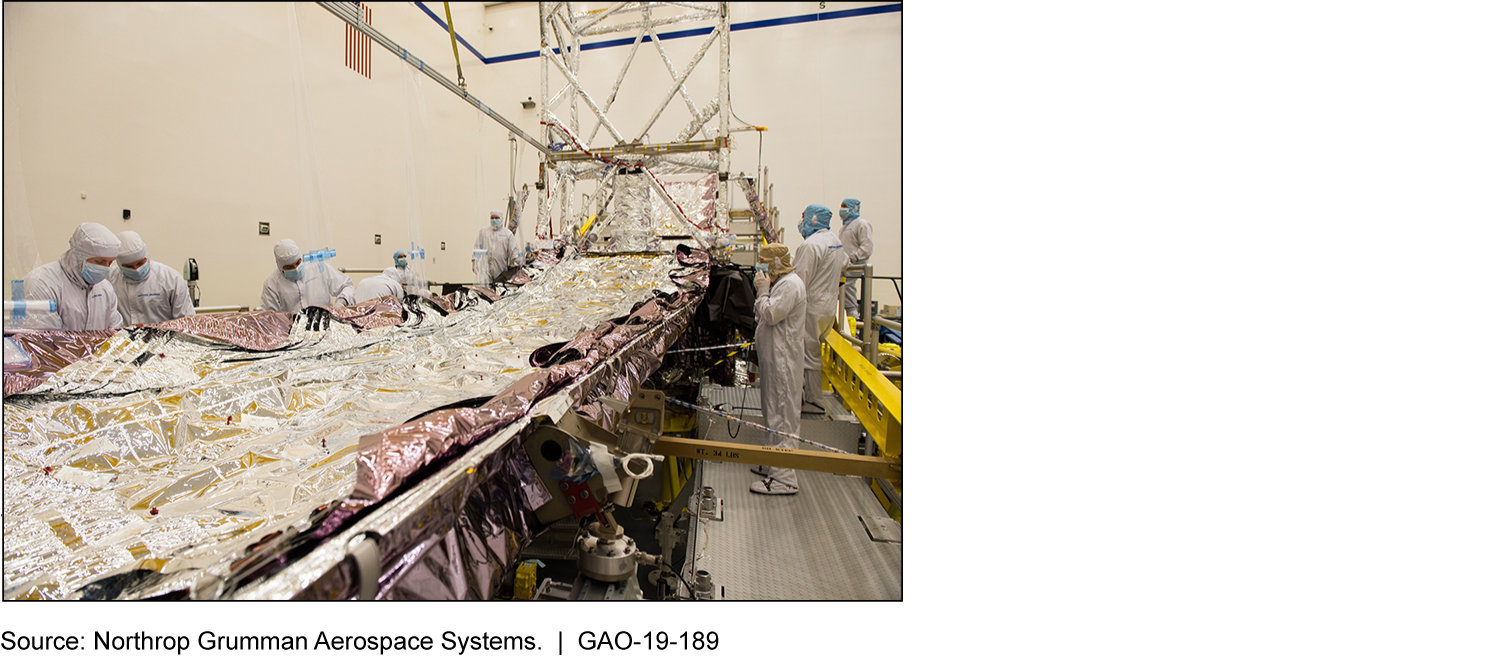James Webb Space Telescope: Opportunity Nears to Provide Additional Assurance That Project Can Meet New Cost and Schedule Commitments
Fast Facts
The James Webb Space Telescope, the planned successor to the Hubble Telescope, is one of NASA's most complex projects.
Since fall 2017, NASA has delayed the telescope's planned launch 3 times, due to factors like workmanship errors. NASA has taken some steps to ensure that the telescope can meet its new launch date of March 2021, such as increasing its oversight of contractors.
We recommended NASA update an analysis to determine the likelihood of meeting its new launch date and cost estimate for the James Webb Space Telescope.
NASA's acquisition management has been on our High Risk list since 1990 due to persistent cost and schedule growth.
Technicians working on the James Webb Space Telescope's primary mirror

Photo of technicians on scaffolding, working on JWST's primary mirror which is made up of smaller mirrors.
Highlights
What GAO Found
In June 2018, the National Aeronautics and Space Administration (NASA) revised the cost and schedule commitments for the James Webb Space Telescope (JWST) to reflect known technical challenges, as well as provide additional time to address unanticipated challenges. For example, the revised launch readiness date of March 2021 included 5.5 months to address a design issue for the cover of the sunshield (see image). The purpose of the sunshield is to protect the telescope's mirrors and instruments from the sun's heat. NASA found that hardware on the cover came loose during testing in April 2018. The new cost estimate of $9.7 billion is driven by the schedule extension, which requires keeping the contractor's workforce on board longer than expected.
Technicians and Engineers Lay Sunshield Layers Flat for Inspection in the Northrop Grumman Clean Room

Before the project enters its final phase of integration and test, it must conduct a review to determine if it can launch within its cost and schedule commitments. As part of this review, the project is not required to update its joint cost and schedule confidence level analysis—an analysis that provides the probability the project can meet its cost and schedule commitments—but government and industry cost and schedule experts have found it is a best practice to do so. Such analysis would provide NASA officials with better information to support decisions on allocating resources, especially in light of the project's recent cost and schedule growth.
NASA has taken steps to improve oversight and performance of JWST, and identified the JWST project manager as responsible for monitoring the continued implementation of these changes. Examples of recent changes include increasing on-site presence at the contractor facility and conducting comprehensive audits of design processes. Sustaining focus on these changes through launch will be important if schedule pressures arise later and because of past challenges with communications. GAO will follow up on the project's monitoring of these improvements in future reviews.
Why GAO Did This Study
JWST, a large, deployable telescope, is one of NASA's most complex projects and top priorities. The project has delayed its planned launch three times since September 2017 due to problems discovered in testing. In June 2018, NASA approved new cost and schedule estimates for JWST. Since the project established its cost and schedule baselines in 2009, the project's costs have increased by 95 percent and the launch date has been moved back by 81 months.
Conference Report No. 112-284, accompanying the Consolidated and Further Continuing Appropriations Act, 2012, included a provision for GAO to assess the project annually and report on its progress. This is the seventh report. This report assesses (1) the considerations NASA took into account when updating the project's cost and schedule commitments and (2) the extent to which NASA has taken steps to improve oversight and performance of JWST, among other issues. GAO reviewed relevant NASA policies, analyzed NASA and contractor data, and interviewed NASA and contractor officials.
Recommendations
GAO recommends NASA update the project's joint cost and schedule confidence level analysis. NASA concurred with the recommendation made in this report.
Recommendations for Executive Action
| Agency Affected | Recommendation | Status |
|---|---|---|
| National Aeronautics and Space Administration | The NASA Administrator should direct the JWST project office to conduct a Joint Cost and Schedule Confidence Level prior to its system integration review. (Recommendation 1) |
NASA agreed with this recommendation. In October 2019, NASA completed the Joint Cost and Schedule Confidence Level (JCL) analysis, prior to the system integration review.
|
